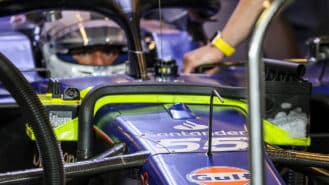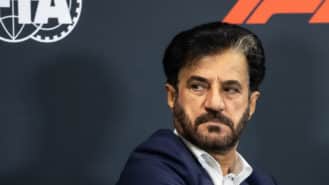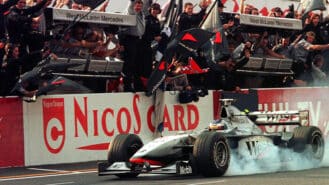This week we meet a mechanic who became a sculptor. Having packed away his much-travelled toolbox he has carved a highly successful new career, creating some spectacular works of art out of carbon fibre and precious metals at his studio near Oxford.

Both David Richards and Jenson Button are proud owners of his dramatic hammerhead sharks while Rubens Barrichello commissioned his former chief mechanic to make a piranha fish, a piece that has gone on to be one of his best-selling works.
Back in 1987 Alastair Gibson shouldered his back pack and came to Europe from South Africa to make his way in motor sport, graduating to Grand Prix racing with both Benetton and BAR-Honda where he was Chief Mechanic from 1999 to 2008.

“Back home my Dad took me to Kyalami for the Grands Prix, I saw the mechanics working in the pitlane, just two or three of them on each car, the driver lying on the pitwall in the sunshine, and I knew that was what I wanted to do. Sometimes you need to be careful what you wish for though, because, as I discovered later, it can be very demanding, and pretty scary, as Chief Mechanic in a Formula 1 team,” Alastair tells me.
“When you’re a mechanic on an F1 car you feel completely in touch with the whole thing, you feel at ease when the car goes out, but as Chief Mechanic you are responsible for every single thing. There are so many peripheral things to think about – has the fuel rig system been bled, is it ready, has the whole job list been done, does everybody have the right information?
“Then there’s the pitstops. Maybe the left front gun guy got sick overnight, so who’s going to take over? Maybe the rear jack man, he’s a pretty cool customer, but then someone has to replace him, so the car’s the last thing you think about – because you know you’ve got good guys on the car – but you’re the bottom line, anything that fails is traceable back to you. There’s this whole big picture that you don’t see on TV, so many little things can go wrong, and that can be scary, especially now when the stops are done in the blink of an eye.”

The Belgian Grand Prix in 1999 was a nightmare for Alastair and his mechanics at BAR. The events of that weekend at Spa tested every member of the team and life in the pitlane was far from glamorous.
“Yeah, that was horrendous, every now and then it happens,” says Alastair. “We had some broken wishbones on the Friday – a manufacturing problem – so I did an all-nighter and one of the guys flew home and put a carbon wrap on the lower outer joints. He brought them back, we put them on for Saturday morning, and then in qualifying Jacques [Villeneuve] had a huge accident at Eau Rouge, completely destroyed the car, and we thought ‘shit, the wishbones have given out’. But Jacques said no, he just tried too hard.
“So he came back with mud all over his overalls and asked if the spare car was ready – well, it was Ricardo Zonta’s spare car that weekend – so we had to change the seat belts and because the Spa pits are so congested we had to get it ready outside. So, when Jacques came out to the car, covered in mud, like a cowboy who’s been chucked off his horse, there was a media scrum. The session re-started, Zonta went out first, and a minute later I looked at the TV screen and saw him destroy his car in another huge accident.

“So now I’m not sure we should send Jacques out, at which point the radios failed, so everyone is shouting, it’s madness, but Jacques goes out and qualifies. Meanwhile, we need more cars, so we divert the test truck on its way to Monza, but that meant another all-nighter as the cars were in low downforce spec, with test engines and gearboxes, so a complete change round.
“Amazingly, both cars finished the race, so that was great, but then driving home on Sunday night with all the guys in the VW bus I fell asleep and woke up near Liege with the thing grinding itself away on the central armco, sparks flying everywhere. So we missed the flight and well, yeah, it was just one of those weekends.”
Alastair spent 14 years in the F1 pitlane, never missing a race, and realised his childhood ambition. From so many memories, he remembers working with Barrichello and Button at BAR with a smile.
“They worked very well together and were a pleasure to work with. Some drivers take time to talk to the mechanics, take an interest, and Rubens was good like that, taking all of us go-kart racing when we went to Brazil, things like that.

“Jacques was different, he never really got close to us. One time we were testing at Valencia and we moved his car from the left hand side of the garage to the right hand side and he came in and hung around on the wrong side. Then he figured he didn’t know the guys on the car that side and walked across to the other side… so, you know, if you have a driver like Rubens, who buys you an ice cream every now and then, appreciates you, then it’s better for the team.
“We certainly had respect for them, all you had to do was stand at the bottom of Eau Rouge for a few laps, see them hanging it out, and you knew they’d all worked their way up from banging wheels in Formula Ford and Formula 3. You may not always work out what makes them tick, but it helps when they take time to chat.”
These days Alastair is happy to have stopped at the top, given himself time carve a new career as an artist. You can see his work at www.carbonart45.com and see the results of his life beyond the pressures of the Grand Prix pitlane.









